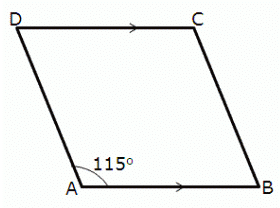Test: Parallelograms Basic Properties - Grade 9 MCQ
15 Questions MCQ Test - Test: Parallelograms Basic Properties
In a parallelogram ABCD, if ∠A = 115°, then ∠B, ∠C and ∠D are

| 1 Crore+ students have signed up on EduRev. Have you? Download the App |
Which of the following is not a parallelogram?
In the figure ABCD is a ||gm in which ∠DAB = 80° and ∠DBC = 60°, then ∠CDB and ∠ADB are equal to
A quadrilateral is a ______ if a pair of opposite sides is equal and parallel
If every pair of adjacent sides of a quadrilateral are equal, then the quadrilateral is a
In a parallelogram ABCD, if ∠A = 60°, then ∠D is equal to:
Each diagonal of a parallelogram divides it into two
Statement 1: AB||DC and AD||BC
Statement 2: AB = DC and AD=BC or a quadrilateral ABCD to be a parallelogram,__________
Perimeter of a parallelogram is 22 cm. If the longer side, measures 6.5 cm, the measure of the shorter side will be:
In the figure ABCD is a square. A line segment DX cuts the side BC at X and the diagonal AC at O such that ∠COD = 105° and ∠OXC = y. Then y is equal to
Which of the following is not true for a parallelogram?
In a parallelogram, if ∠A = (2x +25)° and ∠B = (3x – 5)°, the value of x is
If an angle of a parallelogram is four-fifths of the adjacent angle, then the angles of the parallelogram are
In fig., PQRS is a parallelogram in which ∠PSR = 125°, ∠RQT is equal to

















